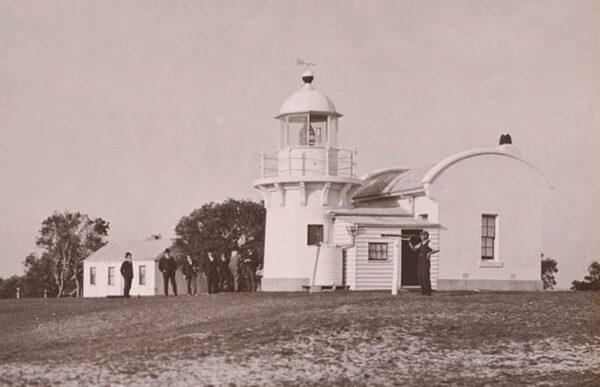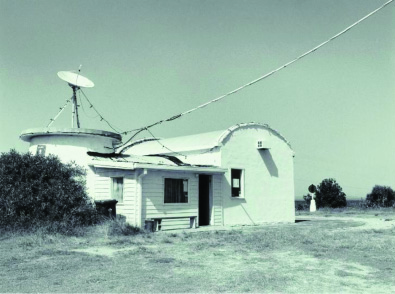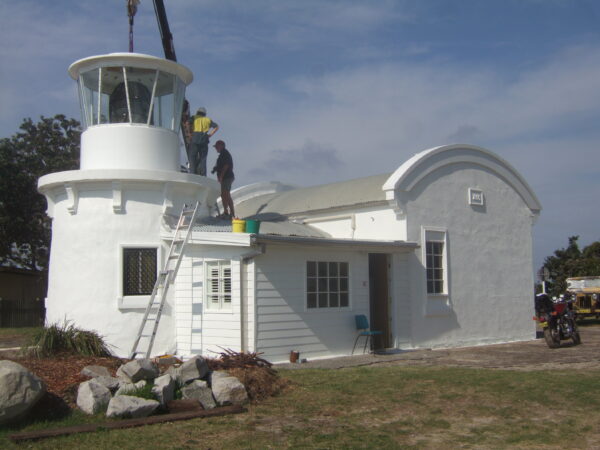Light on the Hill
Strolling across the grassy threshold of Pilot Hill towards the lighthouse you feel you are entering a timeless realm steeped in history and unspoilt natural beauty. The stark white tower is a spectacular sight up close, especially when you look up at it against a bright blue sky; it defies its humble beginning.
When the Pilot Station was established in 1854 crossing the river bar was a major obstacle to navigation. In 1862, when the Department of Harbours and Rivers commenced the river mouth improvements, a fixed signal to passing ships was created using a kerosene lamp attached to a pole near the signal staff.
Sailing masters made a deputation in 1865 to the Colonial Treasurer for a better system. A beacon, comprising a large fixed red kerosene light placed on a bench in a small wooden sentry box whose shutters could be opened at night to dispense the rays 10 to 13 kilometres out to sea, was erected in the same position as the light pole for $240.
One of the Pilot boatmen, William Walker supervised of the light. The pilot’s daughter Jane Freeburn also tended it as a child making her way through the brush on the headland with a bodyguard of Aborigines to protect her from possible predators.

In 1877 moves were made to construct a proper lighthouse and the Colonial Architect, James Johnstone Barnet, was assigned the design, construction and supervision of it. The style was derived from that of Francis Greenway, designer of the first Macquarie Lighthouse at South Head, Sydney. A Grafton building contractor, William Kinnear was awarded the contract for $2194 and completed the structure in 1879. William Walker had been appointed first lighthouse keeper and held the position for 40 years. Quarters were constructed for him adjacent to the lighthouse in 1905. The keepers’ job was a demanding one as lives depended on the correct functioning of the light. The light was converted to fully automatic in 1925.

The construction of the Pacific Hotel in mid 1934 affected the ray viewing from out at sea and a suggestion was made to rebuild the lighthouse on the extreme eastern point of the headland. The Boulder Construction Company began work in late February 1955 and the new lighthouse was first lit on 22 December 1955. Standing 17 metres high, it is supported by 5 metres of reinforced concrete foundation imbedded in bedrock and has 3 flashes of one second each, repeated every 10 seconds.
The original lighthouse was then demolished. Blocks from the lighthouse were used to construct a retaining wall, which still exists today along the side of 40 Yamba Street on the corner of Campbells Lane. A concrete water reservoir was completed on the site in 1957 and replaced by the existing adjacent reservoir in 1986.

In 1987, The Lower Clarence Media Co-operative Society announced a proposal to build a one third size replica of the first Yamba Lighthouse on the site of the old water reservoir to house a production studio, on-air studio and reception area as a bicentennial project. The society raised $20,000 in funds and materials. The building was constructed by volunteer labour and first used in 1989. Plans to complete the replica were announced in May 2010. A local businessman, Howard Hall, instigated a search for a suitable lantern which was located by a local lighthouse enthusiast and author, John Ibbotson. He contacted the Australian Maritime Safety Authority (AMSA) and the Australian Maritime Systems (AMS) who donated a 19th century Fresnel lens and Lamp house. These were installed on 17 November 2011.

When you next see the lighthouse, standing firm against the battering of fierce winds and stormy weather remember how it epitomises the ‘mastery of man over nature’ to safely guide those at sea around the protruding headland, rocks and into the dangerous river entrance.

John McNamara and Sue Spence, Port of Yamba Historical Society.